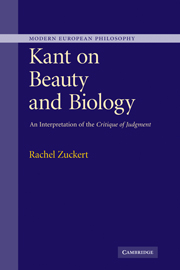Book contents
- Frontmatter
- Contents
- Acknowledgments
- Note on citations
- Introduction
- 1 The problem: The unity of the diverse
- 2 Reflective judgment and its principle: Preliminary remarks
- Part I Teleological judgment
- Part II Aesthetic judgment
- Introduction to Part II
- 5 Beautiful objects: Subjectively purposive form
- 6 Aesthetic pleasure: The feeling of subjective, projective temporality
- 7 The free harmony of the faculties: Purposiveness as the principle of aesthetic Beurteilung
- 8 The justification of aesthetic judgment: Purposiveness as the principle of reflective judging
- Conclusion
- Bibliography of works cited
- Index
5 - Beautiful objects: Subjectively purposive form
from Part II - Aesthetic judgment
Published online by Cambridge University Press: 22 September 2009
- Frontmatter
- Contents
- Acknowledgments
- Note on citations
- Introduction
- 1 The problem: The unity of the diverse
- 2 Reflective judgment and its principle: Preliminary remarks
- Part I Teleological judgment
- Part II Aesthetic judgment
- Introduction to Part II
- 5 Beautiful objects: Subjectively purposive form
- 6 Aesthetic pleasure: The feeling of subjective, projective temporality
- 7 The free harmony of the faculties: Purposiveness as the principle of aesthetic Beurteilung
- 8 The justification of aesthetic judgment: Purposiveness as the principle of reflective judging
- Conclusion
- Bibliography of works cited
- Index
Summary
Kant claims that when we find an object beautiful, we are appreciating its “purposive form,” a claim that has been both extremely influential and widely criticized. Using the preceding analysis of purposiveness as the principle of teleological judgment as a model, I shall suggest a novel interpretation of this claim: just as purposiveness describes the unity of the diverse as grounded in the reciprocal means–ends relations among parts/functions of an organism (in teleological judgment), so too does purposiveness characterize the unity of the diverse as such (purposive form) that holds among the sensible properties of an object experienced as beautiful. The form of the beautiful object is, however, “formally,” rather than “materially,” purposive: the relations among its properties are not causal relations, but reciprocal relations of contrast and complement that render the object intelligible, or unify it as purposive for cognition. Thus, I shall suggest, Kant holds that in aesthetic experience the beautiful object is appreciated as an individual, as a unity, as comprising indeterminately many of its sensible properties as inextricably interrelated to make the object what it is; in aesthetic judging, we appreciate what has been called an object's individual form.
As I shall argue, this reading of Kant's aesthetic formalism renders his aesthetic theory a richer, more plausible, and less narrowly subjectivist description of aesthetic experience than is frequently believed. The “objectivist” reading of Kant's aesthetics I propose is, I shall argue however, consistent with Kant's denials that aesthetic judgments are objective judgments.
- Type
- Chapter
- Information
- Kant on Beauty and BiologyAn Interpretation of the 'Critique of Judgment', pp. 181 - 230Publisher: Cambridge University PressPrint publication year: 2007



